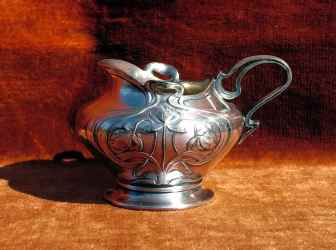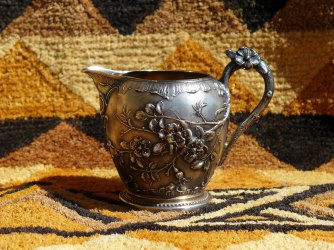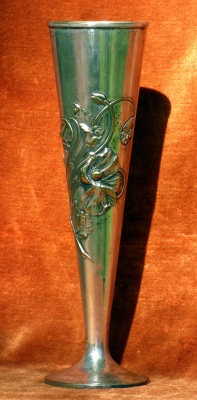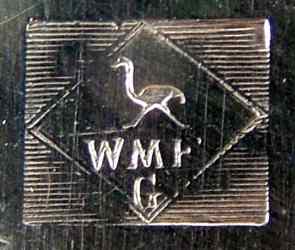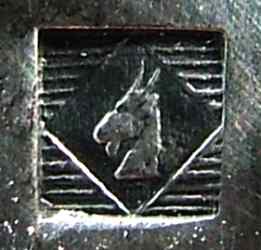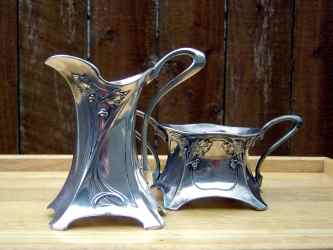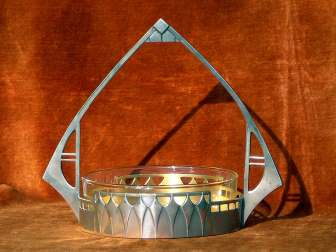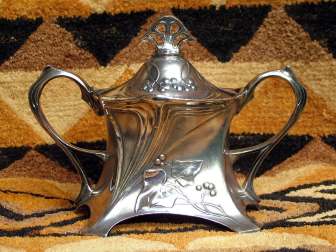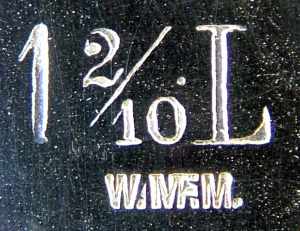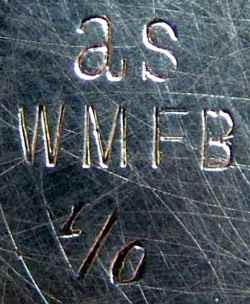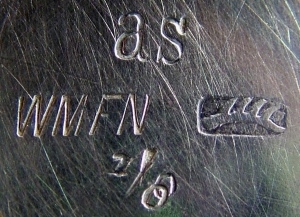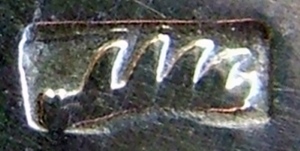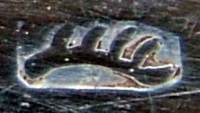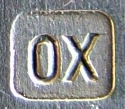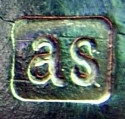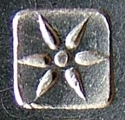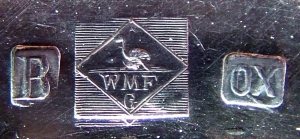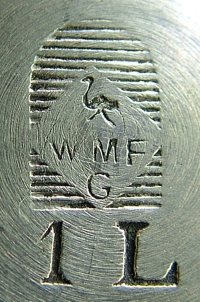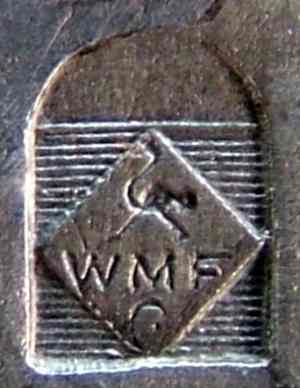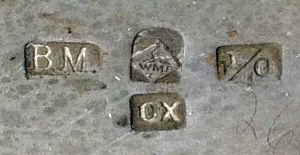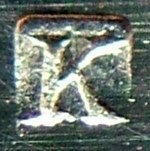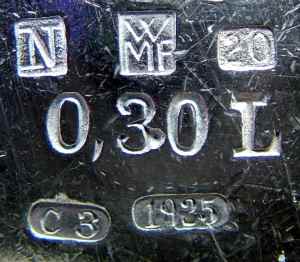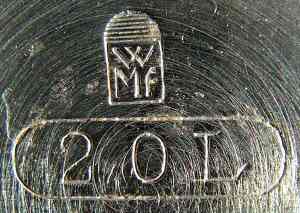A SMALL COLLECTION OF ANTIQUE SILVER |
| an article of Prof. David N. Nikogosyan, University College Cork, Cork, Ireland, for ASCAS - Association of Small Collectors of Antique Silver |

|
(click on photos to enlarge image)MARKS OF EUROPEAN SILVER PLATE: XIV.
|
A view of Geislingen factory taken from the 1912 WMF headed form. |
The WMF silver-plated production made in around 1900-1910 is extremely popular among western antiques collectors. This is because these tableware and household items are considered as the best samples of Art Nouveau style, which is also known as Jugendstil in Germany and Secession in Austro-Hungary. Every year the famous London publisher Dorling Kindersley Ltd. issues an Antique Price Guide, which reflects the current situation on the British antique market. Inside this book two whole pages are devoted to silver-plated WMF items. At the same time, other renowned European producers of silver plate, such as Charles Christofle (France), August Wellner Soehne (Germany), Arthur Krupp Berndorf (Austria-Hungary) are not mentioned at all. On Internet ebay auctions up to ten thousands of silver-plated WMF are selling simultaneously. The corresponding prices often reach hundreds of euro or even more. Recently, Antique Collectors' Club published as a reprint the 1906 English WMF catalogue with an extensive introduction written by renowned German art historian Dr. Graham Dry [3]. This luxurious 400 pages edition contains the description of more than two thousand silver-plated objects of tableware and domestic utensils and mentions the price and quality of each item and serves as self-promotion for the best European Art Nouveau silver-plated products.
Early silver-plated Art Nouveau WMF items made in 1886-1903. |
My interest in WMF marks originated from a trip to Hungary in 2005. Being in Veszprém, I visited a local antique shop and was attracted by a set of four beautiful Art Nouveau silver-plated tea glass holders. The owner of the shop asked only 40 US dollars for this set and I immediately purchased it. On the bottom of each item there was a three-letter mark "W.M.F." and the model number "345". Returning home, I looked through the full list of WMF marks, given in the above-mentioned reprint edition of the 1906 English WMF catalogue [3], as well as in the monograph of Annette Denhardt [1], and did not find anything similar to the marks on my Hungarian tea glass holders. In both sources it was stated that the main WMF mark, used in 1880-1925, consists of the image of a running ostrich put inside the rhombus with a two-line inscription WMF/G, which is in turn placed in a rectangle or in an arch. Such a discovery made me very upset and after some hesitation I came to the sad conclusion that probably my Hungarian holders are not genuine, or, in the better case, a modern replica.
One of my "Hungarian" tea glass holders. |
Whatever happens, it is always for the best! With time I had
realized that on ebay auctions there is a great number of
silver-plated WMF items with marks similar to those on my
Hungarian tea glass holders, that means containing the
three-letter inscription "WMF", with or without dots, and in
some cases the letters "M" and "F" were joined
together. Some of the items were dated by the 1890-1900 period.
Later I found similar marks in online publications for silver
collectors, e.g., in [5]. The extraordinary situation evolved:
some WMF marks exist which are well known to collectors but
somehow ignored in the publications made by serious art
historians. I decided to investigate this point and soon
collected about twenty "unofficial" WMF marks, between them was
also the mark found on my "Hungarian" tea glass holders. The
photographs of these marks are given below in the list of WMF
marks.
Two WMF Art Nouveau vases, issued in 1903, their inscriptions and marks. |
The marks of the first group (used in 1880-1886) contain the word "WMF", formed of three letters, "W", "M", and "F", with dots in between or without and made with a "sans serif" font. Interestingly, sometimes the letters "M" and "F" are joined together. Such a "merged" style of writing was borrowed from the early marks of Berndorfer Metallwarenfabrik (Berndorf Metalware Factory) or BMF in Austro-Hungary, which were in use in 1870-1880 [7].
The BMF mark used by Berndorf Metalware
Factory in 1870-1880.
|
The second group (1886-1903) contains numerous marks with four-letter inscriptions, with dots or without, made with both "serif" (rarely) and "sans serif" fonts and sometimes put in a cartouche. Older marks are made with a "serif" font and put in a cartouche. These four-letter inscriptions are the combinations of the word "WMF" with one of the following letters: "M" or "B", in such a way notating the base metal used for silvering, that means brass ("M" from Messing, the German name of brass) or tin-containing alloy, so-called Britannia metal ("B"), respectively. Rarely, the letter "N" (Neusilber or Alpacca) is also used for marking.
Some WMF hollow ware marks from the second group (1886-1903) |
The third group of WMF hollow ware marks (1898-1903) doesn't contain any three- or four-letter WMF inscriptions. Contrary to the previous group of marks, it consists of a one-word inscription "GEISLINGEN", made by a "sans serif" font and put in a rectangular frame. This mark was issued in order to designate the use of Argentan alloy as a base metal for silver-plating. However, the proposed mark of Argentan alloy was certainly a kind of gimmick, as Argentan is simply another name for Alpacca or Neusilber.
Now a short digression: during the 1997-2013 period, while working in University College Cork, Ireland, I bought for my collection about six WMF hollow ware pieces through ebay.co.uk (at that time I didn't use ebay.de due to my poor knowledge of German). Just recently, I have noticed that the marks of all my items purchased in the UK use a three-letter WMF inscription, made with a "serif" font. Besides, they bear original secondary marks, like EP (electro-plated) or NS (nickel silver). After that, I decided to look through the WMF pieces selling today at ebay.com [wmf art nouveau silver plate, 550 items] and ebay.de [wmf jugendstil versilbert, 1400 items]. While on ebay.com I found rather easily a dozen of pieces with the marks, similar to those on the UK-purchased items, on ebay.de I failed to find any such marks. This finding certainly shows that all my items, purchased in the UK, bear export WMF marks. Moreover, I have found that my other four WMF objects (including the "Hungarian" tea glass holder, discussed above) bought on the territory of former Austria-Hungary bear another three-letter WMF mark, made with a "sans serif" font and put in a rectangular frame, which was also identified as an export mark. It should be emphasized that these marks are specific for hollow ware items, as the export marks for cutlery are different. An exception is the oldest "fancy" export mark with a broken "F" letter in the WMF inscription, which was made with a "sans serif" font and used simultaneously on hollow ware and cutlery items. The export WMF hollow ware marks used between 1880 and 1903 are included in the fourth group.
Typical WMF export hollow ware marks. |
The dating of marks was made by using dated hollow ware items from my collection (I was lucky to purchase sixteen dated pieces), as well as by the presence/absence of certain stylistic details on these items. The correctness of the dating is justified by the fact that most of the items bearing the WMF marks from the first group or early WMFM ones from the second group were issued before the appearance of Art Nouveau style (before 1895) and, in line with this, were not mentioned at all in the 1906 WMF catalogue [3]. At the same time, the majority of the objects from the second group, made in Art Nouveau style and bearing late WMFB marks, were described in the above-mentioned catalogue or in the 1901 catalogue of the Roman Plewkiewicz firm [8].
In 1903, all above-discussed WMF hollow ware marks were replaced by the famous, so-called, "ostrich" WMF mark. It is widely accepted [2,3], that the choice of the ostrich image for the WMF mark could be explained by the consonance between the name of one of WMF founders (Straub) and the German name of the ostrich (Strauss). What was much less known (or simply ignored) is that the ostrich mark looks very similar to the goat mark, which was used in 1888-1932 by the famous French foundry "Manufacture de l'Alfenide". This firm also produced very successful Art Nouveau silver-plated items (under the trade name "GALLIA") and, like WMF, used a tin-containing alloy as a base metal for silvering [9,10].
A famous ostrich mark, used by WMF in
1903-1910 (left), and the goat mark of silvering,
|
Concerning the date of WMF ostrich mark appearance, I have strong evidence that the first ostrich WMF mark appeared exactly in 1903 and not in 1880, as was stated before in [1,3]. Such a statement is supported by the following data:
1) I have at my disposal two advertisements, devoted to Argentan-based WMF products, both hollow ware and cutlery (see photos of these ads in accompanied paper on the marks of WMF cutlery). These ads were issued in 1898 and in 1903. So the production of WMF items from the third group of marks (predecessors of those with ostrich mark) continued until 1903.
2) I have collected three dated WMF products with GEISLINGEN mark, a 0,3 L silver-plated teapot, dated 1901, and two 20 cm long silver-plated forks, each dated 14.11.1902.
3) I purchased a decorative silver-plated vase, bearing the WMFM mark and dated 31.07.1903, see the photo above. So the production of WMF items with marks from the second group of marks (predecessors of those with ostrich mark) also continued until 1903.
4) Very recently, after a decade of continuous search, I finally bought a small beautiful beaker with the first ostrich mark and dated 1903, see the photo above.
I also possess in my collection a number of WMF pieces, bearing the ostrich mark and dated 1904 (twice), 1907 (twice) and 1910. I saw a WMF piece on Internet, dated 1909. Therefore, I can conclude that the first ostrich mark appeared in 1903 and was used until 1910.
WMF Art Nouveau pieces marked by the first "ostrich mark" (1903-1910). |
In 1909/1910, two new WMF ostrich marks were introduced. They bear the image of a running ostrich inserted in a rhombus with a two-line inscription WMF/G, which in turn is placed inside a fully (or partly) dashed arch, see photos below. These two marks were used during a long period of time. According to [1,3], the first of these two small-size marks was applied on WMF goods, exported to France. In my opinion, after 1914 the export to France was stopped due to obvious reasons and after that this mark was applied to the goods made from non-ferrous metals and their alloys, like copper, brass, nickel, etc. The silver-plated products with such a mark are very rare. Contrary to that, the production of non-ferrous WMF products with this mark continued until 1930. The second ostrich mark was introduced in 1910 for the internal market and was used for silver-plated products until 1925. This supposition is justified by the dated WMF objects collected by me and possessing such a mark; they are dated 1910, 1914, 1916, 1920 and 1925.
The ostrich marks, containing the image of ostrich put in rhombus, which is further
|
It should be emphasized that the first three ostrich marks for hollow ware are accompanied by numerous additional marks (see below inside the list of WMF marks). Amongst these marks two are abundant; they are associated with the artificial change of colour of silver coating to the grey (mark "OX", so-called, oxidized silver) or very dark (nearly black) grey (mark "as", so-called, antique silver finish). The reason for such artificial darkening is that the WMF pieces were often issued together with glass inlets (e.g., centrepieces for the table), or were used with the glass (e.g., tea glass holders), and the darkened silver coating goes perfectly with the glass. In connection with this, it is very regretful to realize that many WMF pieces with the darkened silver coating were ruthlessly polished up to a full glitter by ignorant antiques dealers or ebay sellers, effectively "killing" the genuine appearance.
WMF Art Nouveau non-silvered tea glass holder marked by the second "ostrich mark" (1909-1930). |
WMF Art Nouveau sugar bowl marked by the third "ostrich mark" (1910-1925). |
From 1920, WMF introduced the new small mark for silver-plated items, containing a special 2D combination of three letters, "W", "M", and "F", placed in a rectangle. As I have two WMF items with this mark dated 1922 and 1925, I thought that this new mark was used until the mid-twenties. However, according to recently found information (see the reference in the accompanying paper), the period of use for that mark could be prolonged up to 1930. The same 2D combination of these three letters, placed in a partly dashed arch, was turned to account as the main mark for silver-plated items for next five years. Finally, the same 2D combination of three letters, "W"", "M", and "F", but placed in an "empty" arch, was used in 1935-1945.
WMF marks, containing a 2D combination of
three letters, "W", "M", and "F", placed in
|
In the second half of the Twenties, to mark highly-artistic products, designed in fashionable Art Deco style, WMF reintroduced the image of a running ostrich in a rhombus. This ostrich mark differs significantly from other ostrich marks. Firstly, there is an absence of a rectangle or an arch. Secondly, the size of the rhombus is much larger. Thirdly, the inscription of "WMF"/"G" under the ostrich disappeared. Fourthly, the tail of the Art-Deco ostrich is either hidden, or turned up in comparison with the tail of the Art Nouveau ostrich (Mark 6 in the list of WMF marks given below), which is always turned down.
A decorative WMF ash-tray made in Art Deco style. |
Art Deco WMF marks, containing the image of
the running ostrich in a rhombus and used in
|
From 1925, the marking of silver-plated WMF hollow ware items became rather poor. Additional marks were not used at all. Even the amount of silver used for plating was not designated. Therefore, it is rather difficult to distinguish silver-plated and metal WMF hollow ware products issued between 1925 and 1945. This occured partly as a consequence of World Economic Crisis and the following disappearance of silver-plated tableware fashion. Nevertheless, the WMF foundry focussed its efforts on other products, e.g., stainless steel tableware, and survived this hard time. The production of WMF silver-plated tableware continued until at least 1970.
All photographs in text were made by David N. Nikogosyan. The photographed
items are from private collection of David N. Nikogosyan, Bonn, Germany.
LITERATURE
[1] Annette Denhardt. Das Metallwarendesign der
Württembergischen Metallwarenfabrik (WMF) zwischen 1900 und
1930. Historismus Jugendstil Art Deco. (Lit Verlag, Munster, 1993), pp.1-231 [in German].
[2] Dedo von Kerssenbrock-Krosigk and Claudia Kanowski, Modern
Art of Metallwork (Berlin: Bröhan Museum, 2001), pp.352-365.
[3] Art Nouveau Domestic Metalwork from Württembergische
Metallwaren Fabrik, Reprint of 1906 Catalogue, Second Edition (Antique
Collectors' Club Ltd., Woodbridge, 2008), pp.1-392.
[4] David N. Nikogosyan. Hollow Ware Marks of Warsaw Silver
Plate Factories Operated in the Russian Empire: Bros. Henneberg,
Bros. Buch, Wola Factory, Plewkiewicz & Schiffers.
https://www.ascasonline.org/articoloDICEM165.html, 2012.
[5] Giorgio Busetto. A Small Collection of Antique Silver and
Objects of Vertu. https://www.silvercollection.it/, 2012
[6] David N. Nikogosyan. Early WMF Silver Plate Marks. Silver Magazine, Vol.43,
No.1, pp.18-20 (2011)
[7] Ingrid Haslinger, David N. Nikogosyan. Early Marks of
Berndorf Metalware Factory. Silver Magazine, Vol.42, No.1,
pp.12-15 (2010)
[8] Joanna Paprocka-Gajek. Platery Warszawskie. Katalogi i
Cenniki Firmowe. Plyta CD. Warszawa: Muzeum Palac w Wilanowie,
2010, pp.1-375 [in Polish]. English translation: Silver Plated
Items produced in Warsaw. 28 Catalogues and Price Lists of 8
Warsaw Silver Plate Companies on a CD disc.
[9] David N. Nikogosyan. Marks of European Silver Plate: VII.
Gallia, Alfenide/Christofle, France.
http://www.ascasonline.org/windowOTTOB77.html, 2010
[10] David N. Nikogosyan. Gallia and its Predecessors: History and Marks. Silver
Magazine, Vol.45, No.5, pp.32-40 (2013)
List of WMF Hollow Ware & Tray Marks
For each mark, first the main inscription/image is given, then the full images together with the secondary markings are presented, after that each secondary marking is illustrated separately and explained.
further WMF marks and information:
Cutlery and Napkin Rings Marks
WMF History
Dr. David N. Nikogosyan
- 2013 -
 www.silvercollection.it |
|
This is a page of A Small Collection of
Antique Silver and Objects of vertu, a 1500 pages richly illustrated website offering all you need to know about
antique silver, sterling silver, silverplate, Sheffield plate, electroplate silver,
silverware, flatware, tea services and tea complements, marks and hallmarks, articles,
books, auction catalogs, famous silversmiths (Tiffany, Gorham, Jensen, Elkington),
history, oddities ... HOME - SITE MAP - SILVER DICTIONARY - COOKIES CONSENT AND PRIVACY OTHER ARTICLES ABOUT: ANTIQUE SILVER SILVER PLATE ENGLISH SILVER FRENCH SILVER |


